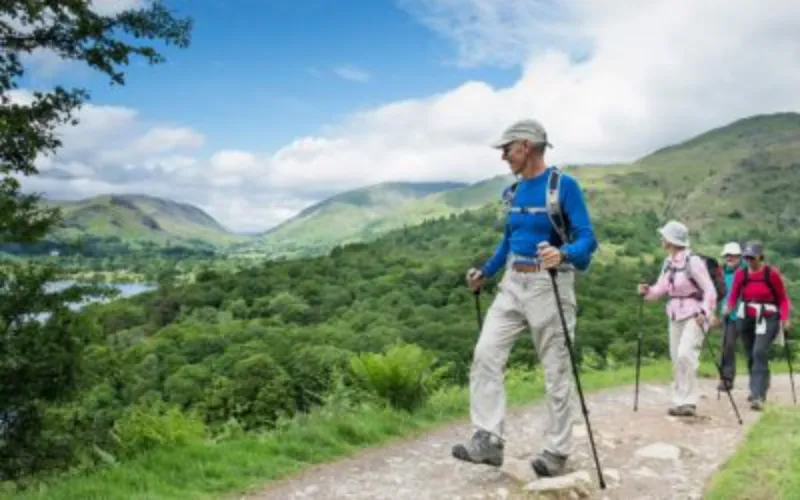1) INCREASE YOUR DISTANCE OR AMOUNT OF HILL WALKING GRADUALLY OVER TIME
One of the most amazing things about your body is its ability to adapt to the stresses and strains that we place upon it. By gradually increasing your walking distance, the amount of hills or the amount of weight you might carry in a rucksack, your body will in turn strengthen your muscles, tendons and even change the structure of your bones over time.
These adaptions can take longer for some tissues:
- – MUSCLES APPROXIMATELY 6-8 WEEKS
- – BONE STRUCTURE 8-12 WEEKS
- – TENDONS APPROXIMATELY 12 WEEKS
If we increase the amount of walking too quickly the tissues are unable to adapt fast enough to keep up and this can sometimes lead to muscular and tendon pain and in severe cases bone stress injuries.
To try and avoid this, a good rule of thumb is to limit increases in your walking volume (this can include amount of hill walking and distance) by no more than 10% a week.
2) HAVE THE RIGHT SHOES AND BREAK THEM IN
Having good waterproof footwear and well cushioned socks can help you to reduce your risk of blisters when walking. Blisters are your bodies protective response to friction against the skin which can be caused by shoes that are either too tight fitting or too loose. Gradually increasing the among of time you spend wearing a new pair of boots allows your feet and skin to adapt to the walking shoe to help prevent blisters occurring.
A good pair of cushioned socks can also really help. Our Practice Manager Kayleigh has got into Wainwright bagging recently and after complaining of blisters after several walks we bought her a pair of ‘1000 Mile’ walking socks which she has been road testing since and reports it has solved the issue.
3) BUILD THE RIGHT TYPE OF STRENGTH IN YOUR THIGH MUSCLES TO REDUCE KNEE PAIN WHEN WALKING DOWNHILL
Knee pain triggered by longer periods of downhill walking is a common problem patients come to us with in clinic. Whilst there can be several different factors that can contribute to this, a lack of what we call eccentric strength in the thigh muscles is a common factor.
Eccentric strength is the amount of force a muscle can produce as it is lengthening. When walking downhill your thigh muscles have to control your body weight against gravity as you bend your knees which lengthens your thigh muscles. This type of strength isn’t something most of us use to that extent on a regular basis and can lead to an increase in pressure behind the knee cap and increased knee pain.
A good way to help reduce this is practicing strength training exercises at home that specifically target the eccentric strength of your thigh muscles.
An easy way to start off is by slowly sitting down on a chair (whilst counting to 8) with your legs hip distance apart, to make this harder rather than fully sit down on the chair get your bottom to just touch it then come back into standing. Once you can do 3 lots of 8 repetitions with a short 1 minute rest in between you can progress to level 2.
Level 2 – have your feet staggered whilst you perform the same exercise, the larger the stagger the more body weight you have to put on the leg closet to the chair.
Level 3 – try the same thing but this time with all your weight on 1 leg.
4) KEEP HYDRATED
It’s easy to get dehydrated whilst walking and this can contribute to reduction in your walking speed and muscle cramps so make sure you take plenty of fluids with you. To help keep you properly hydrated you should be consuming approximately 1 litre of water for every 2 hours of hiking although this can increase if the weather is especially hot.
A useful investment is a CamelBak or water hydration pouch that fits in your rucksack and has a drinking tube with a bite valve on it. This encourages you to take regular small sips of water without having to stop and take your water bottle out of your pack.
5) USE WALKING POLES TO HELP IF YOU STRUGGLE WITH BALANCE OR A LACK OF STRENGTH WHEN GOING UP OR DOWNHILL
Walking poles help with balance and stability especially if you have a tendency to role your ankles on rougher ground. They can also help to reduce the load on your hips and knees when going up and downhill which can be especially useful if you suffer with arthritis in those joints. If you have difficulty gripping poles there are different shaped handles that can make it easier and less painful to grip.
You may well need to adjust the height of your poles dependent on the terrain on which your walking check out the guide below
This is meant as a guide only. If you are struggling with knee pain please don’t continue experiencing it, and letting it affect your day-to-day activities, or hobbies.
Physiotherapy works.
We help lots of people every year with similar issues, we can help you too.
Get in touch.
